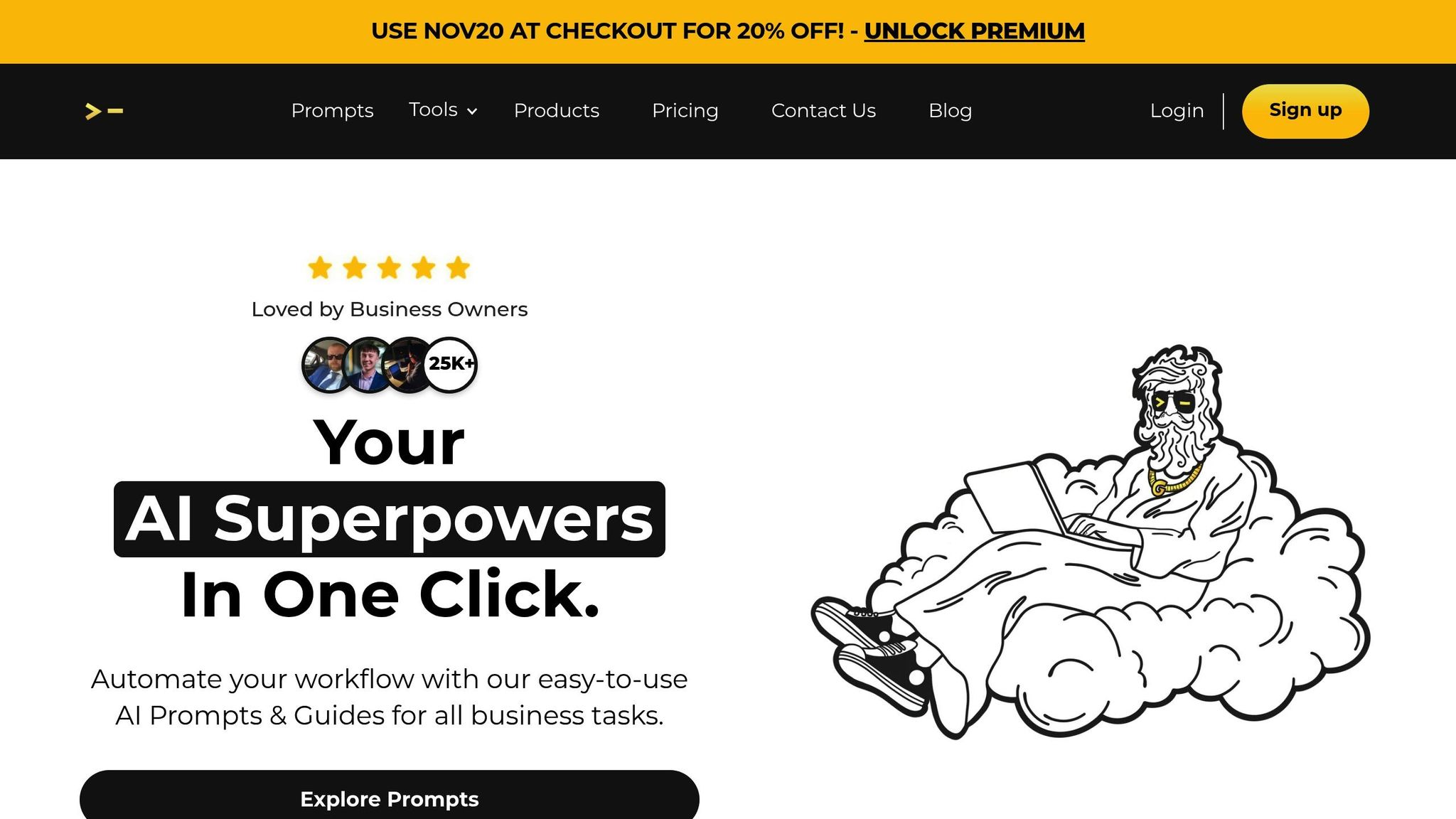
You don’t need to be a tech expert to get great results with AI tools. Whether it’s ChatGPT for writing, Midjourney for visuals, or Claude for analysis, simple, clear instructions are enough to unlock their full potential. Forget complex techniques - here’s how you can save time and boost productivity with beginner-friendly strategies:
With resources like God of Prompt’s 30,000+ templates, anyone can simplify work, improve efficiency, and achieve professional results - fast.
AI tools are software applications powered by artificial intelligence, designed to help you tackle tasks more quickly and efficiently. Think of them as smart assistants that can process your input and deliver actionable results in no time.
These tools function by analyzing the information you provide and generating responses based on learned language patterns. For example, when you ask ChatGPT to draft an email, request Claude to review a document, or use Midjourney to create an image, you're interacting with a system that understands context and delivers relevant outcomes.
What makes modern AI tools stand out is their easy-to-use interfaces. Most operate through simple chat windows or web forms where you can type your requests in plain English. This simplicity allows professionals in business and marketing to achieve excellent results without needing technical expertise. It’s proof that you don’t need advanced skills to get meaningful outcomes from these tools.
One common myth about AI tools is that you need to master complex prompt engineering techniques to get good results. The truth? You don’t. These tools are designed to be intuitive, so even basic communication skills are enough for most business and marketing tasks.
Advanced prompt engineering, which includes techniques like chain-of-thought reasoning and few-shot learning, can deliver sophisticated results. However, for everyday tasks, it’s overkill. Most users achieve excellent outcomes with straightforward, conversational requests.
Simple prompts are highly effective for daily needs. For instance, you can ask an AI tool to "write a professional email declining a meeting" or "draft three social media captions for our new product launch." These clear and direct requests often deliver exactly what you’re looking for - no technical know-how required.
The real difference between novice and experienced users isn’t their ability to craft intricate prompts - it’s their understanding of the tool’s capabilities and how to express their needs clearly. Once you know what an AI tool can do, you can make better requests and get more precise results.
AI tools also adapt to context. If the initial output isn’t quite right, you can refine it by asking for adjustments like "make it more formal" or "shorten this." This back-and-forth approach is often more effective than trying to create the perfect prompt on your first attempt.
Pre-built prompts simplify everything. Instead of spending time learning prompt engineering, you can rely on templates and formulas that are already proven to work. These shortcuts save time and ensure you get professional-quality results for your business needs.
Ultimately, the goal is to solve problems and meet objectives, not to add unnecessary complexity to your workflow. AI tools are here to make your tasks easier, not harder. By focusing on your goals and leveraging these tools effectively, you can achieve great results without diving into technical details.
Pre-built prompt libraries are collections of ready-to-use prompts designed to simplify your interactions with AI tools like ChatGPT, Claude, or Midjourney. Instead of starting from scratch and experimenting with prompts, these libraries offer tested options that are organized by purpose and category.
Think of them as cookbooks for AI tools. Just like following a reliable recipe saves you time in the kitchen, these libraries save you from the trial-and-error process of crafting prompts for common tasks. They include prompts refined through real-world use, ensuring they deliver consistent results.
These libraries are usually categorized by industry and function, making it easy to find prompts tailored to specific needs. Whether you're working on marketing campaigns, writing email templates, creating social media posts, optimizing for SEO, or automating business tasks, there's likely a prompt ready for the job. Each comes with clear instructions and examples, so you can quickly adapt them to fit your requirements.
The key benefit here is speed and ease of use. You simply copy a prompt, personalize it with your details, and generate professional results in minutes. This eliminates hours of testing and tweaking, even if you have minimal experience with prompt engineering.
Using pre-built prompts is straightforward. Just follow these three steps: choose the right prompt, customize it, and execute it with your AI tool.
Step 1: Identify your goal. Are you drafting a product announcement email, coming up with social media captions, or writing SEO content? Once you know what you need, browse the relevant category in your prompt library. The organization by business function makes it simple to locate the right template.
Step 2: Personalize the prompt. Each prompt includes placeholders for details like your company name, product information, or target audience. Replace these placeholders with specifics. For instance, a marketing prompt might contain placeholders like "[PRODUCT NAME]" or "[TARGET AUDIENCE]" - just swap in your product and customer details.
Step 3: Execute and refine. Paste the customized prompt into your AI tool and review the output. If it needs fine-tuning, you can ask for adjustments, such as making it more formal or adding urgency to a call-to-action. This ensures your final content aligns with your goals.
By using pre-built prompts, content creation becomes faster and more efficient. Instead of spending half an hour crafting the perfect blog post prompt, you can grab a tested template and have a solid draft ready in minutes. This is especially helpful for businesses that need to produce a high volume of content regularly.
These steps tie seamlessly into the extensive resources offered by God of Prompt, which we'll explore next.

God of Prompt takes the concept of pre-built libraries to the next level with a vast collection of over 30,000 AI prompts. These prompts are bundled into categories tailored for tools like ChatGPT, Claude, Midjourney, and Gemini AI, covering nearly every business need without requiring advanced skills.
Their Complete AI Bundle includes prompts for tasks like marketing, business operations, financial management, e-commerce, education, sales, and productivity. Whether you're a solo entrepreneur or part of a larger team, you'll find prompts designed to address your challenges quickly and effectively.
For more specific needs, there are specialized bundles:
What’s more, these collections come with lifetime updates, ensuring they stay relevant as AI tools and market demands evolve. All prompts are organized within Notion, making it easy to search, sort, and customize them as needed. This system saves you from endless scrolling and helps you quickly locate the right prompt.
The pricing is flexible, catering to businesses of all sizes. You can start with free access to 1,000+ ChatGPT prompts and 100+ Midjourney prompts. For more advanced needs, you can purchase specialized packs, ranging from $37 for the Writing Pack to $150 for the complete collection. Plus, every purchase includes a 7-day money-back guarantee, so you can try the prompts without risk.
These prompts are designed to deliver real results, tackling challenges like generating leads, improving customer service, crafting engaging marketing copy, and streamlining business workflows. With a focus on practical outcomes, they enable you to see immediate benefits, no matter your technical expertise.
You don’t need to be a tech wizard to get better results from AI tools - what matters most is clear and detailed communication. The more specific you are, the closer the output will align with your expectations.
For example, instead of saying, "write a marketing email", try something like, "write a marketing email for a 30% off sale on running shoes aimed at 25-40-year-old fitness enthusiasts with a friendly but urgent tone." Adding this level of detail helps the AI understand exactly what you’re looking for.
If the first attempt doesn’t hit the mark, don’t give up. Provide feedback like, "make this more professional" or "shorten it to 100 words." Most AI tools can easily adjust based on straightforward instructions like these.
Context is key. If you’re working on related tasks, let the AI know. For instance, if you're creating social media posts tied to an email campaign, mention that connection. This helps the AI maintain consistency across your content, which is particularly useful when crafting a cohesive marketing strategy or content series.
Another tip is to ask the AI to explain its choices. If an output feels off, you can request clarification: "Why did you structure this email this way?" Use its explanation to refine your instructions and guide future outputs more effectively.
Lastly, save prompts that work well. When you find a formula that delivers great results, keep it in a document or note-taking app. Over time, you’ll build a personal library of prompts you can tweak and reuse for similar tasks.
Once you’ve mastered these basics, staying updated on new features and tools will help you take things even further.
As you refine your skills with AI tools, staying informed about the latest advancements can help you get even better results. Thankfully, keeping up doesn’t mean diving into complex technical details - it’s about knowing where to look for reliable updates.
Tech news sites and blogs are excellent sources for timely information. For example, in November 2025, eWeek.com covered developments like Google Gemini 3, Elon Musk’s views on robots gaining human-like consciousness, UBTECH's Walker S2 humanoid robot, and the global expansion of Google Flight Deals. These updates show how tech news can keep you in the loop about what’s happening in the AI world.
Curated expert lists also save time by highlighting the best tools and features. In September 2025, Synthesia.io published "The 45 Best AI Tools for 2025 (Tried and Tested)", a detailed guide with reviews, use cases, and pricing. Resources like this help you discover tools that are already vetted by professionals.
Engaging with product communities is another great way to stay informed. Many AI companies host active GitHub repositories, forums, or comment sections where users share tips and updates. For instance, in January 2025, Seeed Studio encouraged users of its SenseCraft AI tool to suggest new models, frameworks, or improvements via GitHub and blog comments. These communities are often goldmines of practical advice and insights.
To make staying updated manageable, set up a simple routine. Bookmark 3-5 reliable sources - like an AI news site, the official blogs of tools you use, and a curated resource list - and check them once a week. Spending just 15-20 minutes weekly can keep you informed without taking up too much time.
Follow the tools you use on social media or subscribe to their newsletters. Companies often announce new features or updates through these channels, so you’ll be among the first to know about improvements that directly impact your work.
Finally, experiment with new features gradually. When you come across a new tool or capability, test it out on a small task you’re already familiar with. This low-stakes approach helps you learn its benefits without disrupting your workflow.
You don’t need a computer science degree or hours of study to start using AI tools effectively. As we’ve discussed in this guide, AI is within everyone’s reach when you focus on clear communication, take advantage of pre-made resources, and embrace a bit of trial and error.
Here’s the big takeaway: clear and specific beats complicated every time. Whether you’re writing marketing emails, creating social media posts, or optimizing business processes, straightforward instructions often yield the best results.
Tools like pre-built prompt libraries make things even easier. Instead of starting from scratch, you can rely on proven templates that professionals have fine-tuned. For example, God of Prompt offers over 30,000 AI prompts covering areas like business, marketing, SEO, and productivity. With these ready-made solutions at your fingertips, tackling tasks becomes quicker and simpler.
And don’t forget - progress comes from practice, not perfection. Each time you use an AI tool, you learn more about what works and what doesn’t. Save the prompts that deliver great results, tweak them, and try new approaches to refine your skills.
The beauty of AI is that it’s designed for everyone, not just tech-savvy experts. By sticking to beginner-friendly strategies and tapping into curated resources, you can boost your productivity and streamline your workflow without getting tangled in technical jargon. The tools are here, the resources are ready, and your AI journey begins with your next prompt.
Getting started with AI tools is much easier than it might seem, even if you don’t have a tech-heavy background. Many of these tools are built with simplicity in mind, offering features that make them approachable for beginners - no coding or advanced skills required.
The key is to start with tools that match your goals, whether you're looking to improve productivity, enhance your marketing efforts, or support your business operations. Many platforms come with ready-to-use prompts and easy-to-navigate interfaces, making the learning curve much gentler. Begin by testing out one or two tools and take advantage of resources like curated prompt collections to help you get the hang of things. With just a bit of practice, you can tap into the power of AI without diving into complex technical details.
Pre-built prompt libraries make using AI tools a breeze by offering ready-made templates that prioritize consistency, efficiency, and precision. Instead of spending time crafting prompts from the ground up, these libraries let you dive straight into your tasks, skipping the technical hassle.
What’s great is that these templates are designed to work smoothly with AI tools, enabling even beginners to produce polished, professional results. They simplify workflows and lower the barrier to entry, making advanced tools more approachable for everyone.
To make AI-generated content work for you, start with easy-to-use strategies and ready-made prompt libraries. These resources simplify the process, making it easier to convey your goals to the AI without needing any advanced expertise.
You can further improve the outcomes by tweaking prompts slightly or using templates that match your specific tasks. This method helps you get the most out of AI tools for areas like business, marketing, or productivity, all while keeping the process straightforward and efficient.





